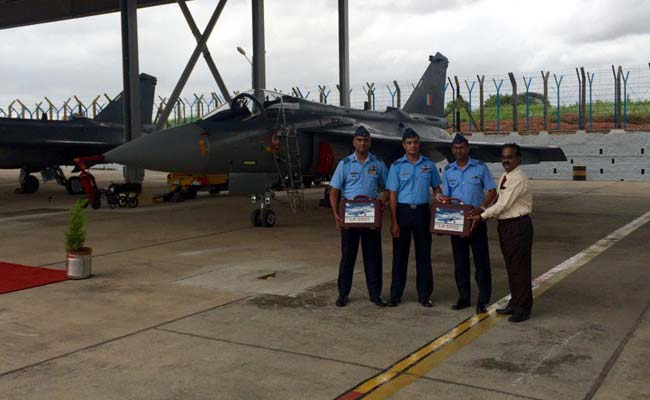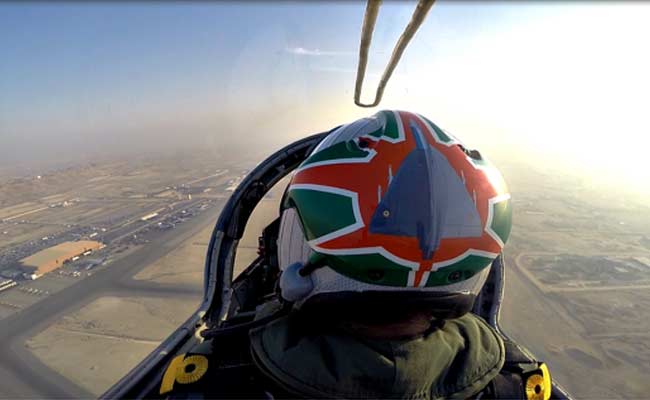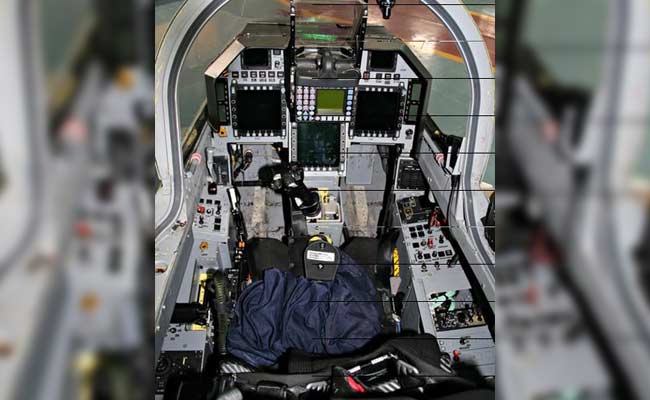The induction ceremony in Bengaluru began a spectacular water-cannon salute
Bengaluru:
It's been almost every Air Chief's favourite whipping boy - an Indian-built fighter jet delayed so inordinately that it came to be seen as a promise that would never be kept.
But three decades after the Tejas Light Combat Aircraft went into development, there is a grudging acceptance that the fighter which has been officially inducted into the Air Force in Bengaluru today is in many ways, world-class.
Speaking to NDTV, Air Commodore Rohit Verma, a former IAF fighter pilot who went on to head the National Flight Test Centre says, "I was one of the biggest critics of this programme...but after I came back from my first flight, I was a total convert. This aircraft flies as well if not better than the Mirage 2000."
While the delay in delivery cannot be justified, there have been fierce debates on why that happened. State-run Hindustan Aeronautics or HAL, which is the lead player in the Tejas project, says the Air Force kept shifting the goal post on what exactly it wanted from the jet.
 The manufacturer also says it was hit by sanctions imposed by the US after the Pokhran nuclear test in 1998, which placed crucial technology out of reach.
The manufacturer also says it was hit by sanctions imposed by the US after the Pokhran nuclear test in 1998, which placed crucial technology out of reach.
CD Balaji, the head of the Aeronautical Development Agency which has designed the Tejas says the project now has mature levels of technology and Indian engineers, scientists and pilots are able to modify the jet without any external inputs.
"Today is a red letter day where we have the aircraft reaching the user ultimately and in addition, we also have the Naval version of the LCA which is being developed," Mr Balaji said.
The Navy, for its part, is convinced that one day a variant of Tejas will fly off the deck of one of India's aircraft carriers out at sea.
 Speaking to NDTV, Navy's Commodore JA Maolankar says, "This is the foundation on which we hope to build a carrier borne fighter. So a lot of the core technologies that have been developed - like the fly by wire system and the wing and the glass cockpit are now the technological base upon which we are building Naval capabilities."
Speaking to NDTV, Navy's Commodore JA Maolankar says, "This is the foundation on which we hope to build a carrier borne fighter. So a lot of the core technologies that have been developed - like the fly by wire system and the wing and the glass cockpit are now the technological base upon which we are building Naval capabilities."
The Air Force, for its part, has insisted there are better options available in the world market, jets built by manufacturers who have been in the business of military aviation for decades. The Tejas, they have argued in the past, will be obsolete by the time it enters Air Force squadron service.
Except it isn't. Not in the least.
Equipped with a modern Israeli multi-mode radar, the Elta 2032, state-of-the-art Derby air- to-air missiles to attack enemy jets, and modern laser designator and targeting pods to hit ground targets, the Tejas is, in many ways, as capable as the French-built Mirage 2000, the aircraft used by HAL as its bench mark. Every pilot that has tested the jet has sworn by the Tejas's flight control system and the ease with which it manoeuvres. Not a single Tejas fighter has been lost to an accident during flight tests during 3,000 sorties.
 Confronted by these facts, critics of the jet say the Tejas is not indigenous at all. They point out that the engine is American, its radar and weapons Israeli, its ejection seat British -all that in addition to several other imported systems and subsystems. HAL counters that leading Western designs like the French Rafale and the Swedish Gripen also have imported systems because it's simply too expensive and too time-consuming to develop components that have been perfected and are available for purchase.
Confronted by these facts, critics of the jet say the Tejas is not indigenous at all. They point out that the engine is American, its radar and weapons Israeli, its ejection seat British -all that in addition to several other imported systems and subsystems. HAL counters that leading Western designs like the French Rafale and the Swedish Gripen also have imported systems because it's simply too expensive and too time-consuming to develop components that have been perfected and are available for purchase.
So has the Tejas programme added to India's engineering and scientific knowledge? It has. The fly-by-wire system gives computer-controlled inputs to charter the flight of the aircraft - and it's completely Indian. To deal with enemy jets, the Mission Computer which processes data provided by sensors like the radar is Indian. In fact, the hardware and the software of the Mission Computer has been designed around an open architecture framework which means that it can be upgraded in the future. The jet itself is constructed using Indian-made carbon fibre composites which are light-weight and ultra-strong alternatives to metal. A host of general systems dealing with everything from fuel management to steering of the nose-wheel are all made in India.
A key sensor, Tarang - the Radar Warning Radar, which lets the pilot know of enemy aircraft or surface-to-air missiles in the vicinity of the Tejas, is also Indian.
Terming it a "very proud moment", Air Marshal Jasbir Walia, the Commander in Chief of the Southern Air Command, today said, "It's a milestone as far as self-reliance is concerned..., it is the first resident fighter squadron."
 Modern fighter aircraft, including the air force's top gun, the Sukhoi-30, are notoriously unreliable and maintenance-heavy. Less than 60 per cent of Sukhoi fleet is available at any one time to conduct missions, a huge concern for the air force. HAL says the Tejas will be available more than 70 per cent of the time when called in for missions and are targeting a minimum of 80 per cent, far in excess of what the IAF is presently able to achieve with most of its other jets.
Modern fighter aircraft, including the air force's top gun, the Sukhoi-30, are notoriously unreliable and maintenance-heavy. Less than 60 per cent of Sukhoi fleet is available at any one time to conduct missions, a huge concern for the air force. HAL says the Tejas will be available more than 70 per cent of the time when called in for missions and are targeting a minimum of 80 per cent, far in excess of what the IAF is presently able to achieve with most of its other jets.
With the Indian Air Force's 45 squadron, the "Flying Daggers", now taking ownership of their first fighters, the Tejas programme will have turned over to an all-new page. As a light fighter based on requirements that were last updated more than a decade ago , the Tejas will never be among the best fighters in the world. It will, however, provide the Indian Air Force far more than what they had initially wanted - a MiG-21 replacement
In the Tejas, the air force has a modern fighter which will only get better through modifications and additions to its capabilities.
But three decades after the Tejas Light Combat Aircraft went into development, there is a grudging acceptance that the fighter which has been officially inducted into the Air Force in Bengaluru today is in many ways, world-class.
Speaking to NDTV, Air Commodore Rohit Verma, a former IAF fighter pilot who went on to head the National Flight Test Centre says, "I was one of the biggest critics of this programme...but after I came back from my first flight, I was a total convert. This aircraft flies as well if not better than the Mirage 2000."
While the delay in delivery cannot be justified, there have been fierce debates on why that happened. State-run Hindustan Aeronautics or HAL, which is the lead player in the Tejas project, says the Air Force kept shifting the goal post on what exactly it wanted from the jet.

Tejas is equipped with a modern Israeli multi-mode radar, state of the art Derby air to air missiles and targeting pods to hit ground targets.
CD Balaji, the head of the Aeronautical Development Agency which has designed the Tejas says the project now has mature levels of technology and Indian engineers, scientists and pilots are able to modify the jet without any external inputs.
"Today is a red letter day where we have the aircraft reaching the user ultimately and in addition, we also have the Naval version of the LCA which is being developed," Mr Balaji said.
The Navy, for its part, is convinced that one day a variant of Tejas will fly off the deck of one of India's aircraft carriers out at sea.

The aircraft was named "Tejas", which means radiance in Sanskrit
The Air Force, for its part, has insisted there are better options available in the world market, jets built by manufacturers who have been in the business of military aviation for decades. The Tejas, they have argued in the past, will be obsolete by the time it enters Air Force squadron service.
Except it isn't. Not in the least.
Equipped with a modern Israeli multi-mode radar, the Elta 2032, state-of-the-art Derby air- to-air missiles to attack enemy jets, and modern laser designator and targeting pods to hit ground targets, the Tejas is, in many ways, as capable as the French-built Mirage 2000, the aircraft used by HAL as its bench mark. Every pilot that has tested the jet has sworn by the Tejas's flight control system and the ease with which it manoeuvres. Not a single Tejas fighter has been lost to an accident during flight tests during 3,000 sorties.

More than 3000 sorties of the Tejas fighter have been flown to date
So has the Tejas programme added to India's engineering and scientific knowledge? It has. The fly-by-wire system gives computer-controlled inputs to charter the flight of the aircraft - and it's completely Indian. To deal with enemy jets, the Mission Computer which processes data provided by sensors like the radar is Indian. In fact, the hardware and the software of the Mission Computer has been designed around an open architecture framework which means that it can be upgraded in the future. The jet itself is constructed using Indian-made carbon fibre composites which are light-weight and ultra-strong alternatives to metal. A host of general systems dealing with everything from fuel management to steering of the nose-wheel are all made in India.
A key sensor, Tarang - the Radar Warning Radar, which lets the pilot know of enemy aircraft or surface-to-air missiles in the vicinity of the Tejas, is also Indian.
Terming it a "very proud moment", Air Marshal Jasbir Walia, the Commander in Chief of the Southern Air Command, today said, "It's a milestone as far as self-reliance is concerned..., it is the first resident fighter squadron."

More than 3000 sorties of the Tejas fighter have been flown to date
With the Indian Air Force's 45 squadron, the "Flying Daggers", now taking ownership of their first fighters, the Tejas programme will have turned over to an all-new page. As a light fighter based on requirements that were last updated more than a decade ago , the Tejas will never be among the best fighters in the world. It will, however, provide the Indian Air Force far more than what they had initially wanted - a MiG-21 replacement
In the Tejas, the air force has a modern fighter which will only get better through modifications and additions to its capabilities.
Track Latest News Live on NDTV.com and get news updates from India and around the world

